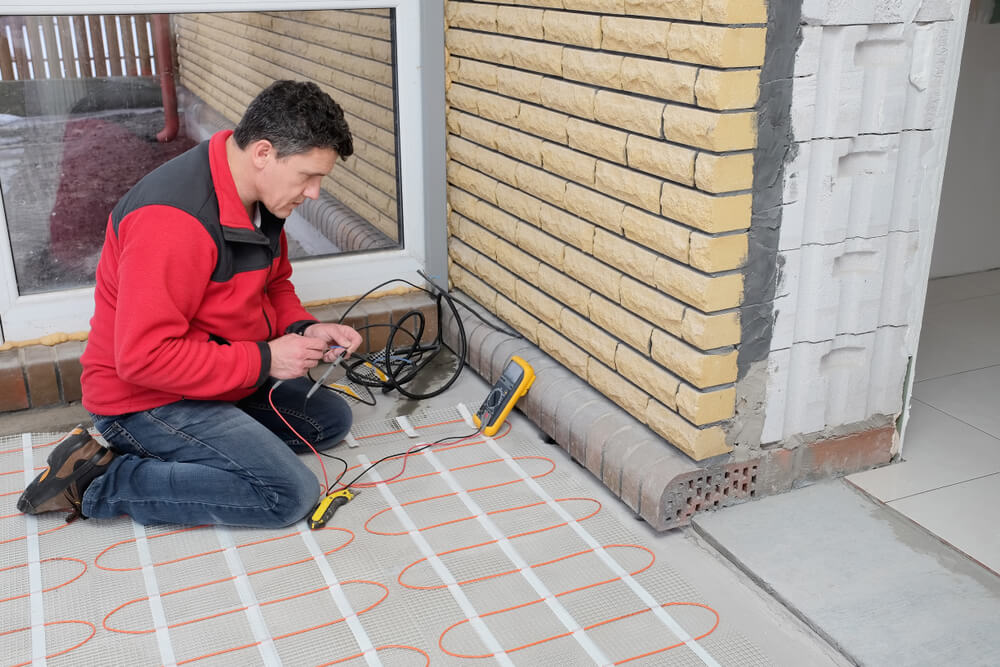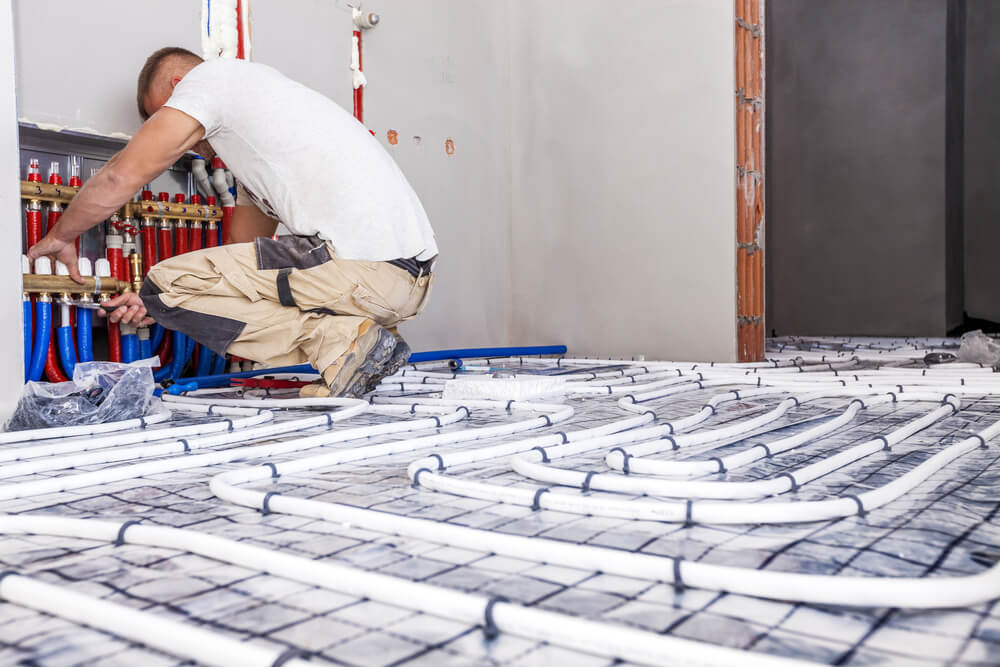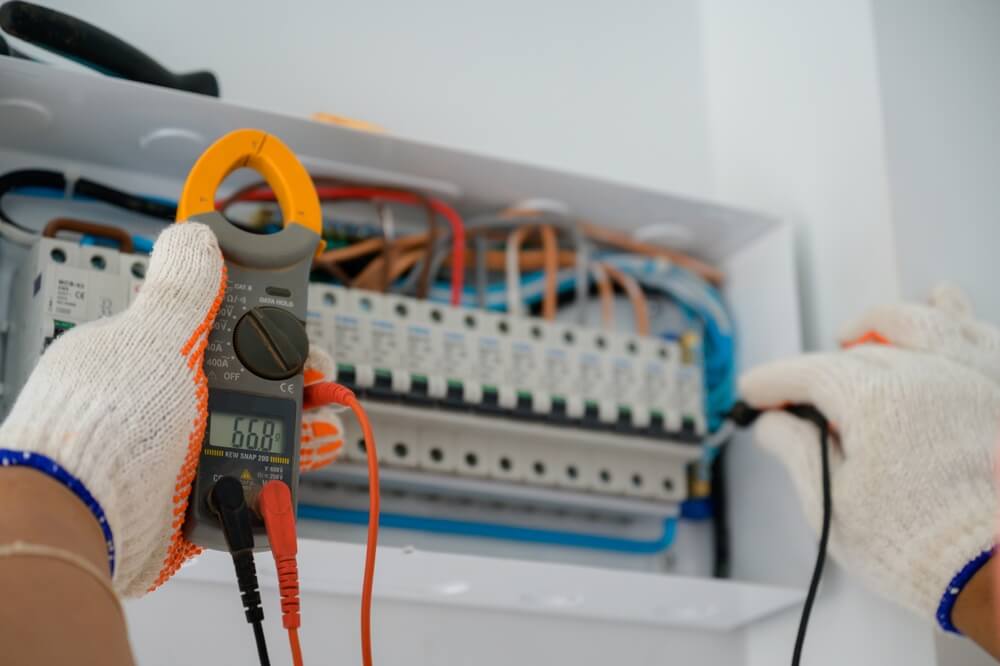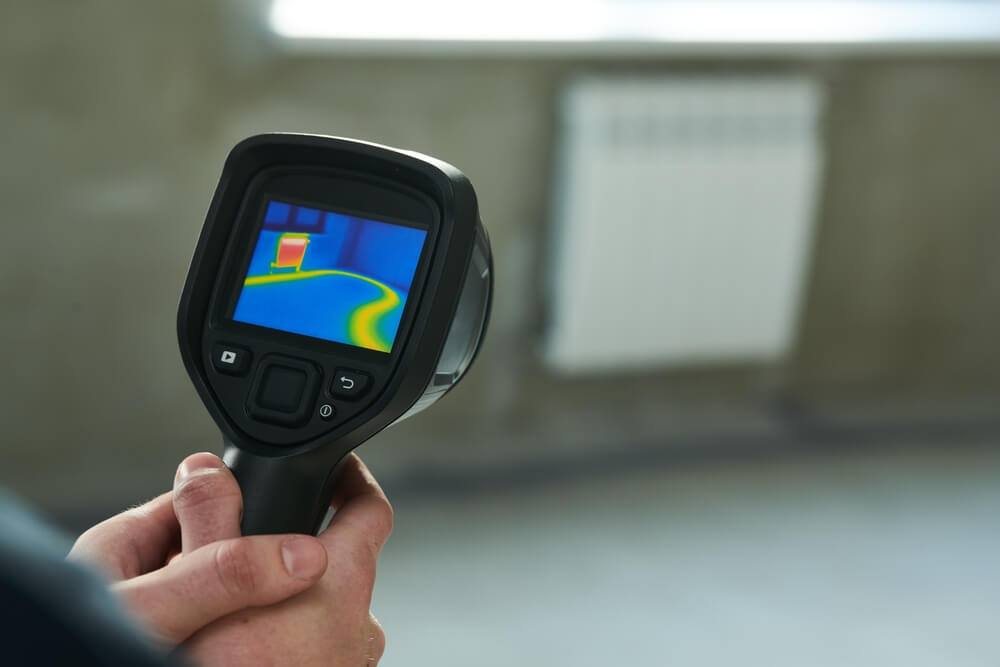Why is My Underfloor Heating Not Working? Solutions and Tips to Fix It

If your underfloor heating system is underperforming—or not working at all—you’re not alone. The most common reasons underfloor heating stops working include a faulty thermostat, damaged heating cable, air trapped in the system, wiring issues, or a tripped circuit breaker. These issues can affect the entire system or specific zones and may require inspection of the boiler, thermostat settings, or floor sensor.
In Ontario, where the winters are harsh and floors feel like ice, electric underfloor heating is more than a luxury—it’s an essential part of modern home comfort. But how do you identify the problem without tearing up your entire floor? And how much will it cost?
Let’s start with the early red flags.
What is an Underfloor Heating System
An underfloor heating system uses either electric heating elements or hydronic (water-based) pipes installed under your flooring to provide radiant warmth from the ground up. The goal is to distribute heat evenly across the entire floor, eliminating cold spots and keeping the ambient temperature consistent. These systems are often hidden beneath tile, laminate, or engineered wood, making them invisible but efficient.
There are two primary types of floor heating systems:
1. Electric Underfloor Heating
This system uses a heating cable or heating mat wired beneath the floor coverings. It’s easier to install in renovations or single rooms and is connected to underfloor heating thermostats that control the desired temperature.
2. Hydronic Underfloor Heating
A more complex system that circulates heated water through pipes beneath the floor. It’s ideal for larger spaces and is typically powered by a boiler or heat pump.
The components of these systems include:
- Thermostat and floor sensor
- Circulation pump
- Pressure relief valve
- Electrical supply and control boards
- Blending valve pin to regulate water temperature
- Expansion vessel to manage pressure changes
When underfloor heating works properly, it operates silently and evenly. But a faulty component—like a circulation pump failure or electrical fault—can disrupt the entire system. As the system is sealed and often covered by floor finishes, identifying the issue demands methodical checking.
Small symptoms like mild heat inconsistency could point to air bubbles, while total heat loss may suggest a main isolating switch supply issue. It all starts with learning what signs to watch for.

Signs Your Heated Floor Might Need Immediate Repair
Most homeowners don’t recognize the early signs of floor heating problems until the system has already failed. But your underfloor heating will often “speak” to you before it fully shuts down.
Here are key signs that signal immediate attention:
1. Uneven or cold floor sections
When parts of your floor are cold while others remain warm, this may indicate a floor heating cable failure or air trapped in one of the heating zones.
2. Thermostat shows active heating, but no warmth
If the thermostat indicates heating, yet the floor remains cold, you might be dealing with a faulty thermostat or a wiring board issue that disrupts the electric supply to the mat or cable.
3. Fluctuating ambient temperature
You may feel the room constantly switching from warm to chilly. This could mean your thermostat settings are not calibrated correctly, or your floor sensor is malfunctioning.
4. Noise under the flooring
Clicking, hissing, or gurgling could suggest air bubbles in a hydronic system or a malfunctioning circulation pump.
5. Boiler keeps losing pressure
For hydronic systems, low boiler pressure often signals leaks, faulty wiring, or problems with the expansion vessel or filling loop.
When these symptoms arise, it’s best not to wait. What may begin as a minor electrical fault can escalate to a full system replacement if neglected. Floor heating is designed to be seamless; when it’s not, something needs checking.
How to Spot Common Underfloor Heating Problems Fast
Before pulling up your floor coverings or calling for backup, a few simple tests can help you narrow down the issue.
1. Start with the thermostat
Check that it’s set to your desired temperature and not in standby mode. Use a non contact voltage tester to ensure it’s receiving power. If unresponsive, it could be a new thermostat is needed.
2. Confirm electrical connections
Inspect the main isolating switch supply and see if the circuit breaker has tripped. For electric systems, any interruption here means the heating mat or heating cable isn’t receiving power.
3. Assess heat across zones
If your home uses multiple zones, test each one individually. If only one area isn’t working, this could mean a faulty actuator, blending valve pin stuck, or pressure-related issue in that zone’s manifold component.
4. Listen to the system
Hydronic systems with air vent problems will often gurgle or spit water into the boiler. This is part of a blocked air escape cycle.
5. Feel for warmth over time
Allow the system to run for 30 minutes. If no difference is felt, the heating element may be burnt out, especially in older electric systems with aging components.
The quicker you identify common underfloor heating problems, the faster you can act—often avoiding costlier damage. If you’re unsure, tracking patterns in zone performance can narrow things down before major faults develop.

Could a Faulty Thermostat Be to Blame Here
When troubleshooting electric floor heating systems, one of the first culprits to examine is the underfloor heating thermostat—and it’s not always the device’s fault. Incorrect installation, programming errors, or even ambient temperature misreadings can all result in heating failure.
Thermostats, particularly digital or smart models, rely on precise data from a floor sensor to maintain the set temperature. If your room isn’t heating evenly or the display shows unusual fluctuations, it might be a sensor calibration error. In systems that rely on a thermostat connected to multiple zones, the issue may not be hardware but a syncing delay.
Other symptoms of a faulty unit:
- Blank screen despite power supply
- Doesn’t respond to manual adjustments
- Incorrect floor temperature shown
- Heating switches on and off too frequently
Before replacing your thermostat, check the wiring. Loose connections between the thermostat and heating mat, or corrosion at the terminals, could mimic the effects of failure. In fact, a surprising number of thermostat problems stem from moisture intrusion, which shorts the terminals and disrupts the electrical system.
Also, revisit your thermostat settings. If your thermostat was recently updated or replaced, it may have reset to factory settings, including temperature limits and heating hours. Verifying these details could resolve performance issues without needing part replacement.
Finally, don’t forget to test the floor sensor independently. If it no longer reads accurately, it might trigger premature shutoff or continuous heating, both of which reduce efficiency and comfort.
Circuit Breaker Keeps Tripping What Now
If your circuit breaker trips every time your electric floor heating system turns on, you’re dealing with an electrical fault—and it shouldn’t be ignored.
The issue usually lies in one of three places:
- The heating mat or heating cable is damaged
- Moisture has entered the wiring connections
- There’s a short circuit in the electrical system
1. How to troubleshoot
Switch off the main isolating switch supply, unplug the floor heating from the circuit, and reset the breaker. If the breaker holds when the heating system is unplugged, the fault lies within the system—most likely the floor heating cable.
2. Use a multimeter or voltage tester
Testing continuity across the cable can identify whether there’s a heating element break. If resistance levels are too low, the cable is shorted and must be replaced.
3. Moisture damage warning
In bathrooms or poorly insulated basements, moisture may seep into joints or under the insulation board, creating arching and tripping the breaker. This requires drying the area and resealing connections.
4. What does fixing cost
This varies depending on damage. See table below:
| Problem | Typical Cost (CAD) |
|---|---|
| Thermostat replacement | $200 – $400 |
| Cable re-routing/patching | $300 – $600 |
| Full system inspection | $150 – $250 |
| Full cable replacement | $800 – $1,500 |
Addressing circuit breaker issues early keeps both your home and heating investment safe from long-term electrical damage.

What to Check When the Floor Temperature Isn’t Right
A room where the floor heating system is working, but the floor temperature doesn’t feel right, can be particularly confusing. The system may seem active—lights are on, thermostats responsive—but comfort is missing. This often boils down to issues with thermostat settings, floor sensor accuracy, or incorrect layout planning.
Start by inspecting the underfloor heating thermostats. Many programmable models let you set a desired temperature, but they also include safety limits to prevent overheating. These settings can conflict, especially if changed unintentionally or during a power outage.
Also, pay close attention to the floor sensor. It’s meant to ensure that the floor reaches a stable, safe temperature. However, if the sensor is installed too close to a heating cable or near an edge, it can give false readings. This leads the underfloor heating thermostat to switch off early, leaving the entire system underheated.
Then there’s the issue of floor coverings. A change from tile to vinyl or carpet can significantly impact heat transfer. Some coverings insulate too well, making it hard for heat to reach the surface even when the system is performing.
Inconsistent heating can also be caused by faulty actuators on zoned systems. If one actuator fails to open, heat may not reach specific areas, even if others are fully functional.
Lastly, check the wiring. A weak or faulty wiring connection between the thermostat and sensor can scramble signals. In these cases, the thermostat thinks it’s too warm and shuts off prematurely, or worse, never activates.
Don’t Ignore an Electrical Supply Breakdown
One of the more dramatic yet often misdiagnosed reasons a floor heating system fails is a total electrical system breakdown. This could manifest as nothing turning on: no response from the underfloor heating thermostats, no click from relays, and no heat from the heating mat.
In these cases, it’s tempting to jump to cable failure, but the first step should always be to check the wiring and main isolating switch supply.
Common causes include:
- A blown boiler fuse if connected to a central system
- Tripped circuit breakers caused by a surge
- Blending valve pin stuck, resulting in the system believing heat is unavailable
- Corrosion or detachment in the wiring connections
- External factors like rodents chewing wiring or water ingress shorting the terminals
Older homes in Ontario might also suffer from aged infrastructure not designed for electric heating loads. These panels might be under-fused or lack grounding, making them vulnerable to faults. If this is the case, even a new underfloor system will suffer intermittent power issues.
Sometimes the issue lies not in the system but in external timers, WiFi relays, or poorly integrated smart-home systems that control the power flow. A failed sync or loss of schedule can cause heating to shut off without your knowledge.
A full continuity test, inspection of wiring board integrity, and visual review of the electrical supply connections can rule out or confirm systemic electrical failures.

What It Costs to Repair Floor Heating Systems
When the underfloor heating system breaks down, one of the first questions is, “How much is this going to cost me?” The answer varies based on whether you’re dealing with electric systems or hydronic ones—and the specific component failure.
Here’s a breakdown of average Ontario repair costs for common floor heating issues:
| Repair Type | Estimated Cost (CAD) |
|---|---|
| Thermostat replacement (standard) | $180 – $300 |
| Thermostat upgrade (smart) | $300 – $450 |
| Cable repair with floor removal | $650 – $1,200 |
| Heating mat replacement (partial) | $700 – $1,300 |
| Hydronic air bleed + refill | $250 – $400 |
| Pressure testing and diagnosis | $150 – $350 |
| Electrical continuity testing | $120 – $200 |
| Sensor or faulty thermostat swap | $150 – $250 |
| Fixing faulty actuator | $180 – $400 |
| Full circulation pump replacement | $600 – $950 |
Costs may rise if floor coverings need to be removed and reinstalled—tile is particularly expensive due to the labor involved.
In rare cases where a boiler blow or major electrical system failure is involved, costs could reach $2,000 or more, especially if drywall or subfloor repairs are needed as part of the process.
It’s also worth noting that while DIY options exist for small fixes, like resetting the thermostat or bleeding air vents, any issue related to pressure relief valves, expansion vessels, or electrical faults should be handled by a qualified professional.
Check Your Boiler Pressure Before Replacing Anything
Before rushing to replace your floor heating system components, always inspect your boiler pressure—particularly if you’re using a hydronic setup. A significant drop in pressure can render even a fully operational system ineffective. The underfloor heating system pressure needs to stay between 1.0 and 2.0 bar for optimal performance.
Too high? You risk damaging the expansion vessel or triggering a pressure relief valve release. Too low? The circulation pump might run dry, leading to flow temperature issues across the entire floor.
Here’s what to check first:
- Read your pressure gauge: If it’s below 1 bar, top up using the filling loop.
- Bleed the air: Use the air vent to release any trapped air affecting the air escape cycle.
- Listen for odd sounds: Pinging or clunking can indicate internal blockages or pressure inconsistencies.
- Look for leaks near manifold components or around the blending valve pin.
If you recently had a boiler blow, the safety systems may have shut off heat delivery. Check the main isolating switch supply and reset it if necessary.
You can also use a foot pump to restore pressure if your system supports manual refilling. However, frequent pressure loss may be a sign of a hidden faulty connection or leak.
Maintaining correct pressure is essential for effective heating and to prevent more expensive issues with components like the pump relay and pin valve. Always confirm system stability before assuming parts like the heating element are at fault.
Isolation Valves Closed Could Stall the Whole System
Another commonly missed culprit? Isolation valves closed either during maintenance or by accident. These valves control the flow of heated water into different zones of your underfloor heating network and are often tucked away on manifolds, near the flow valve, or beside the circulation pump.
If these are left shut—even partially—it restricts circulation to portions of the system or halts it entirely.
Here’s how to assess the issue:
- Check all isolation valves: Use visible flow gauges to determine whether water is passing through properly.
- Verify actuator positions: A faulty actuator may signal open while mechanically staying closed.
- Inspect manifold zones: Problems often arise in multiple zones, particularly if connected to a complex schedule or automated system.
Signs of isolation problems include:
- Uneven heating across the entire floor
- Sudden pressure drops in one or more zones
- One room heating while others stay cold
In systems with electric heating, isolation valves may not be present, but wiring connections can still mimic similar problems. In such cases, always check the wiring from thermostat to heating element or floor sensor.
Also, confirm the pump speed hasn’t been misadjusted. A low-speed setting can cause valve resistance and inefficient flow temperature control. If unsure, a qualified electrician can test each zone for consistent electrical delivery using a non contact voltage tester.
Maintenance Tips to Keep Floor Heating Running
Regular maintenance is the best way to avoid underfloor heating thermostat problems, inconsistent heating, and electrical supply failures. Like any HVAC system, neglect leads to wear, inefficiency, and costly repairs.
Here’s a smart maintenance schedule:
Quarterly:
- Test the floor sensor for responsiveness.
- Review thermostat settings to align with seasonal changes.
- Run an air escape cycle manually if the system sounds gurgly.
- Confirm flow temperature via your underfloor heating thermostats.
Annually:
- Check all wiring connections for corrosion or stress.
- Clean around air vents and manifold boxes.
- Inspect floor coverings for damage from heat cycles.
- Flush hydronic lines using a foot pump and inspect the schrader valve.
Every 2–3 years:
- Replace aging thermostats with a new thermostat to maintain compatibility.
- Test the pump relay and reset the main isolating switch supply.
- Check the boiler pressure and blending valve pin for mineral buildup.
What to look for during maintenance:
- Slow heating element response
- Small pressure drops that build over time
- Dust on floor sensors disrupting accuracy
- Faulty actuator making noise when idle
Simple DIY care—like turning the system on briefly in warmer months—can prevent pump seizure and retain full operation year-round. Keeping documentation of set temperature, ambient temperature, and historical output readings will help spot changes early.
Always shut off power at the main isolating switch supply before conducting any inspections.

Conclusion
Troubleshooting a faulty underfloor heating system doesn’t have to be a mystery. From thermostat issues and floor sensor errors to pressure drops and isolation valve mishaps, there are clear paths to diagnosing and restoring your warm floors. Keeping an eye on boiler pressure, wiring connections, and your thermostat settings is often all it takes to keep your system humming.
Remember: prevention and early action can save you from costly fixes later, especially in Ontario’s colder months. Whether you’re working with a hydronic setup or an electric heating system, staying informed means staying warm.
Give us a call at Heavenly Heat Inc. if you’re ever unsure where the issue lies. We know underfloor systems inside and out, and we’ll make sure your floors stay comfortable, safe, and efficient. You don’t have to deal with cold floors any longer—just let us know, and we’ll take it from here. Warm floors are just the beginning.
